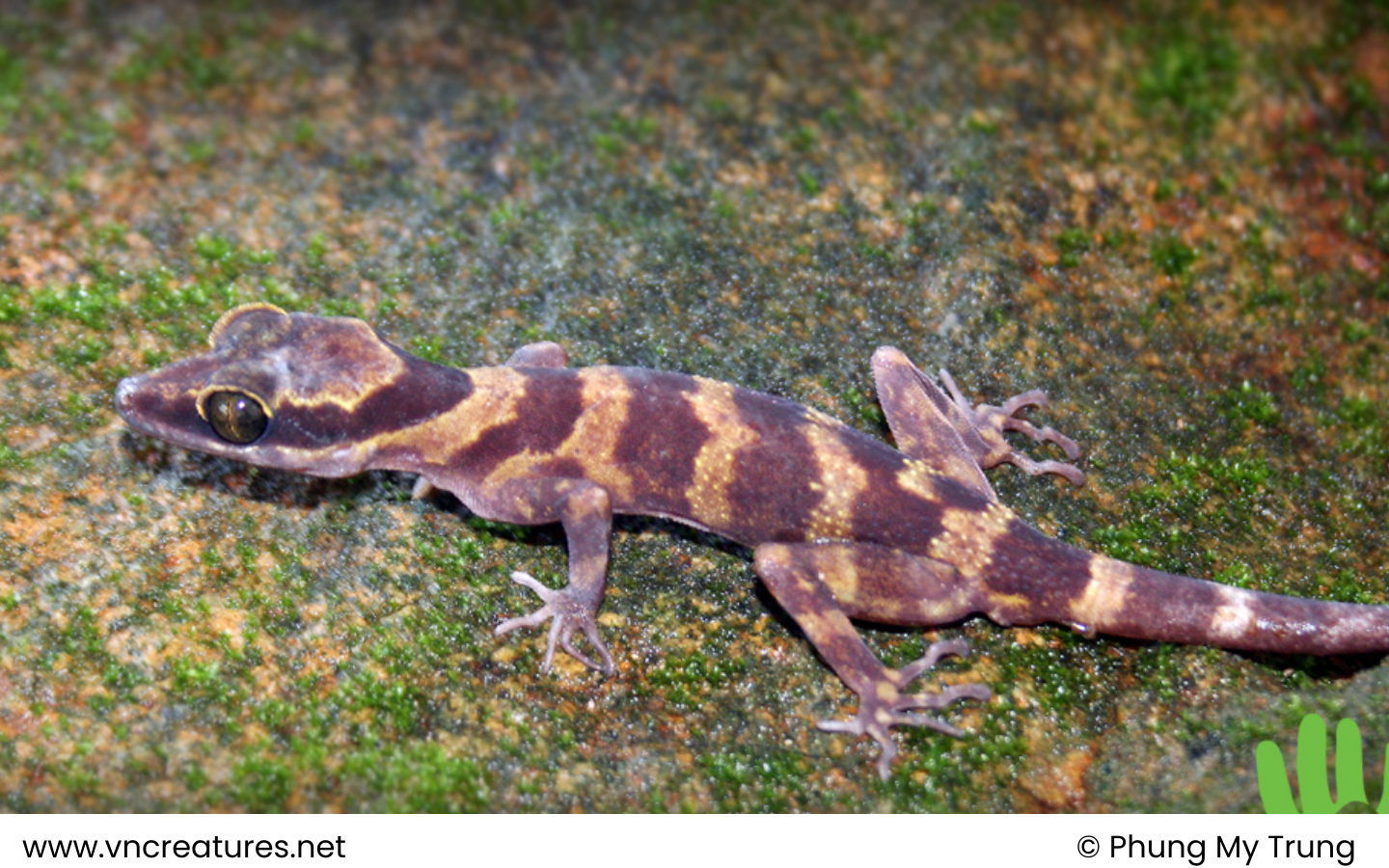
Science name: Cyrtodactylus takouensis – Ngo & Bauer, 2008
Taxonomic: Animalia>> Chordata>> Reptilia>> Squamata >> Gekkonidae >> takouensis
Species status: Endemic ; IUCN status: CR (Critically Endangered Species)
Description:
Physical characteristics:
Cyrtodactylus takouensis is a medium-sized gecko with a snout-vent length (SVL) reaching 80.4 mm. The head is long, narrow, and slightly concave, with distinct large eyes and vertical pupils. The body is slender, with prominent dorsal tubercles and small, scattered conical scales that extend from the head to the base of the tail. The ventral scales are smooth and larger than the dorsal ones, arranged in approximately 39–40 rows at midbody.
Males possess 4 precloacal pores arranged in a linear series, with femoral scales that are distinctly enlarged. The tail is long and cylindrical, with smooth subcaudal scales.
Coloration and Appearance:
The dorsal side is characterized by five narrow, pale cream-colored bands that run between the nape and the hips, interspersed with wider brown markings. The tail is banded with alternating light and dark colors. The head displays a dark brown streak running from the tip of the snout through the eye to the ear, with scattered brown spots on the top of the head. The limbs are marked with pale and brown patterns, and the ventral side is light, with some darker speckles.
Distribution and habitat:
Elevation: Found at an elevation of approximately 450 meters above sea level.
Area: Cyrtodactylus takouensis is endemic to southern Vietnam, specifically in the Ta Kou Nature Reserve, Binh Thuan Province. The species was discovered in Hang To Cave.
Habitat: This species inhabits lowland deciduous forests and is associated with granite rocks and deep caves. It is likely dependent on open areas near well-preserved forests.
Behaviour and ecology:
Lifestyle:
This nocturnal species is active at night, primarily hunting for food around rocky areas and cave entrances.
Reproduction:
The species is oviparous, with females laying two eggs in crevices or under rocks during the early rainy season. The sex of the offspring is temperature-dependent.
Diet:
Cyrtodactylus takouensis feeds mainly on insects and other small invertebrates found within its habitat.
Conservation and status:
IUCN Red List Category and Criteria:
Listed as Critically Endangered (CR) under criteria B1ab(iii) due to its extremely limited range and habitat degradation.
Threats:
The species is threatened by habitat loss and degradation, especially due to deforestation, human encroachment, and the alteration of its cave habitats.
Conservation actions:
The species benefits from the protection provided by Ta Kou Nature Reserve, but further conservation efforts are needed to preserve its habitat and ensure the population’s stability.
Crocodile Trail – The Best Birding Trail in Cat Tien National Park
If you’re a birder or nature photographer planning a trip to Vietnam, few places offer [...]
Cong Troi Trail – Top 1 Dalat Plateau Birding Trail Experience
If you’re a birder or nature photographer planning a trip to Vietnam’s Central Highlands, the [...]
How to Identify the Greater Sand Plover, Tibetan Sand Plover and Siberian Sand Plover
Identification Differences within the Sand Plover Complex: The sand plover group, which was traditionally divided [...]
Highlights of Cat Tien National Park Reptiles and Amphibian Endemics
Spanning over 71,350 hectares of tropical forests, grasslands, and wetlands, Cat Tien National Park is [...]
Highlights of Cat Tien National Park Mammals in a World Biosphere Reserve
In addition to reptiles and birds, Cat Tien National Park is also rich in mammals, [...]
Kontum Plateau Endemic and Highlight bird
Kontum Plateau Endemic And Highlight Bird species like Chestnut-eared Laughingthrush and top birding routes while [...]